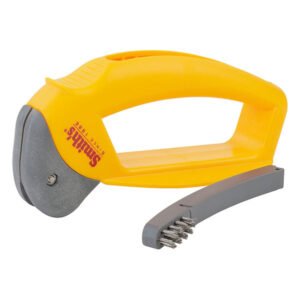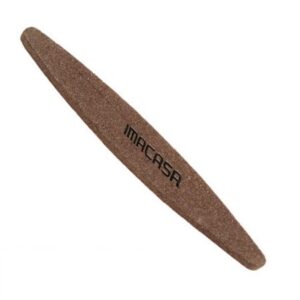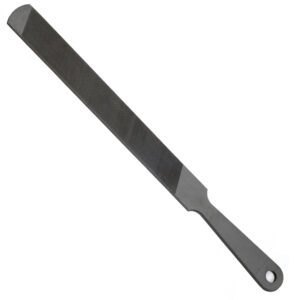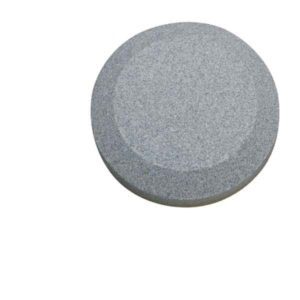Whether you’re putting an edge on a new machete for the very first time, or touching up your blade in the field, we have the tips and tools for you. In this video, Josh demonstrates a few of our most popular sharpeners.
Popular Machete Sharpeners
Putting an Edge On Your Machete
Some machetes we carry do not come with an edge from the factory and will need to be sharpened upon arrival. Be sure to check the product descriptions on MacheteSpecialists.com to see if your machete will need additional sharpening before its first use. Additionally, some customers may prefer a different grind angle on their blade for personal preference or for a specific task. For these tasks, we recommend using a heavy machete sharpener designed to remove significant amounts of metal.
How to Sharpen a Machete using Belt Sanders
Belt sanders are perhaps the easiest and most professional method of sharpening machetes. Belt sanders with some give in the belt work best, as the machete can be given a convex utility edge in the belly of the belt. Light pressure can be applied easily, and it is much easier to keep a straight edge with a belt sander than with a grinding wheel. An inexpensive belt sander will work perfectly for sharpening machetes. Just be mindful of the temperature of the blade.
How to Sharpen a Machete using Grinding Wheels
For people experienced in sharpening blades, a grinding wheel can be useful for removing the initial bluntness of the machete.
Grinding wheels will aggressively sharpen the blade, and are a good option only for initial sharpening, removing large nicks, or restoring rusty and worn machetes.
Grinding wheels can be bought for under $40 dollars and can be used to sharpen all sorts of garden tools, mower blades, and other implements. The key is to set-up a work area with enough space to draw the entire length of the machete, or other tool, across the wheel in one smooth motion to create a continuous edge. Make sure nothing around your grinding wheel can interfere with the path of the blade.
Using a grinding wheel can damage or overheat the blade, so experience is recommended. Dousing the blade repeatedly with water will keep the blade cool. As long as the metal does not overheat and lose its temper you will be fine.
How to Sharpen a Machete using Mill Files and Hones
For a less expensive option, you can use a mill file or a heavy duty hone to give your machete its initial edge. Mill files have teeth that are either rough or smooth (or “bastard” being an intermediary option). The mill files available through our site are double-cut on one side for rough shaping, and single-cut on the other side for finer sharpening.
Typically, the machete is placed at the desired angle and held firm in a vice, then the mill file pushed repeatedly over the blade (push, don’t pull; the teeth are angled away from the handle). Conversely, the blade can be drawn across the secured mill file. In the field, pointed machetes can be stuck in a tree trunk for filing.
Once one side is done, the machete is turned over and the other side is sharpened, so a 30 degree edge is actually two 15 degree bevels. Some military-style machetes have chisel grind blades, which are only sharpened on one side.
When you turn the blade over, check for burrs (thin projections of metal created during the grinding process). The burr can be on either side, and develops on the opposite side of the blade from where you are sharpening. They look like metal shavings clinging to the edge. You will want to make sure all burrs have been removed for a fine edge.
Mill files are good for sharpening large blades, and are not so overly aggressive that novice sharpeners will damage their machetes.
What angle should I make my edge?
When sharpening your machete, it is a good idea to keep in mind what you will be using it for.
If you are using your machete mainly to cut grass or non-woody vegetation, small sharpening angles of 20-25 degrees work best, as razor-sharpness is necessary, and there is little risk of chipping the fine edge.
However, when cutting woody vegetation and branches, a larger sharpening angle of 25-35 degrees is recommended. The more durable edge will withstand the trauma of repeated chopping strokes.
How to Sharpen a Machete using Field Sharpeners
Field sharpeners are used for touch-up sharpening while in the field working, as opposed to the heavy sharpeners which are used for removing metal to shape the initial edge.
Once you begin using your machete, it can quickly dull as you chop vegetation and strike the occasional rock or piece of metal. We sell several different field sharpening stones that can be kept in the pocket and used without oil to touch-up your blade while working.
More Machete Information
Read our other valuable articles on the make, use and care of machetes:
- Machete Buying Guide
- Our 25 BEST MACHETES
- Types of Machetes
- Machete Blade Materials
- Machete Handle Styles & Materials
- Uses of Machetes
- Machetes for Beginners
- Care & Maintenance for Your Machete




